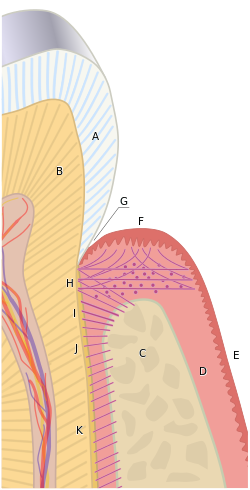Cementum
| Cementum | |
|---|---|

The cementum is the surface layer of the tooth root. Rather than being a passive entity like paint on a wall, cementum is a dynamic entity within the periodontium. It is attached to the alveolar bone (C) by the fibers of the periodontal ligament and to the soft tissue of the gingiva by the gingival fibers (H).
|
|
| Details | |
| Identifiers | |
| Latin | caementum |
| TA |
A05.1.03.057 A03.1.03.007 |
| FMA | 55630 |
|
Anatomical terminology
[]
|
|
Cementum is a specialized calcified substance covering the root of a tooth. The cementum is the part of the periodontium that attaches the teeth to the alveolar bone by anchoring the periodontal ligament.
Cementum is excreted by cells called cementoblasts within the root of the tooth and is thickest at the root apex. These cementoblasts develop from undifferentiated mesenchymal cells in the connective tissue of the dental follicle or sac.
Unlike ameloblasts and odontoblasts, which leave no cellular bodies in their secreted products, during the later steps within the stage of , many of the cementoblasts become entrapped by the cementum they produce, becoming cementocytes. Thus again, cementum is more similar to alveolar bone, with its osteoblasts becoming entrapped osteocytes.
Cementum is capable of repairing itself to a limited degree and is not resorbed under normal conditions.
Cementum is slightly softer than dentin and consists of about 45% to 50% inorganic material (hydroxylapatite) by weight and 50% to 55% organic matter and water by weight. The organic portion is composed primarily of collagen and proteoglycans. Cementum is avascular, receiving its nutrition through its own imbedded cells from the surrounding vascular periodontal ligament.
The cementum is light yellow and slightly lighter in color than dentin. It has the highest fluoride content of all mineralized tissue. Cementum also is permeable to a variety of materials. It is formed continuously throughout life because a new layer of cementum is deposited to keep the attachment intact as the superficial layer of cementum ages. Cementum on the root ends surrounds the apical foramen and may extend slightly onto the inner wall of the pulp canal.
...
Wikipedia
